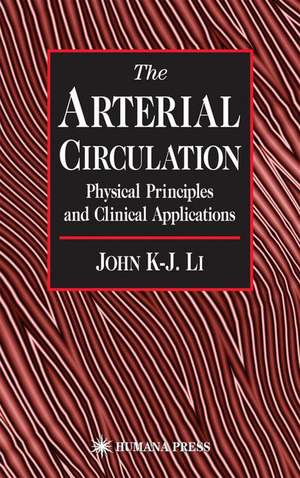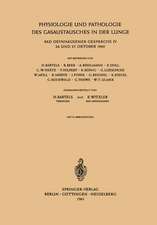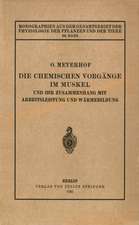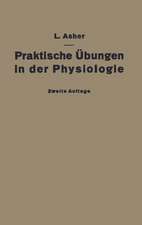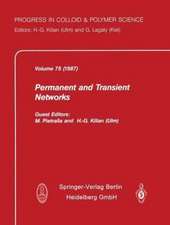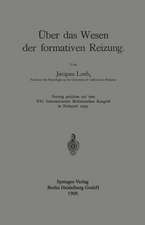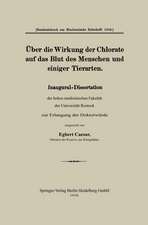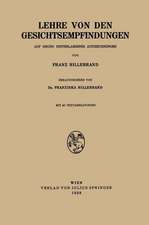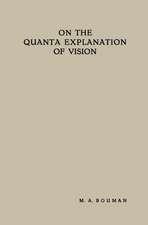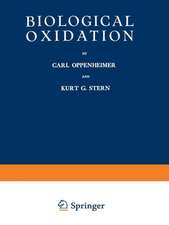The Arterial Circulation: Physical Principles and Clinical Applications
Autor John K-J Lien Limba Engleză Hardback – 5 mai 2000
| Toate formatele și edițiile | Preț | Express |
|---|---|---|
| Paperback (1) | 778.80 lei 6-8 săpt. | |
| Humana Press Inc. – 5 noi 2010 | 778.80 lei 6-8 săpt. | |
| Hardback (1) | 1101.58 lei 6-8 săpt. | |
| Humana Press Inc. – 5 mai 2000 | 1101.58 lei 6-8 săpt. |
Preț: 1101.58 lei
Preț vechi: 1159.56 lei
-5% Nou
Puncte Express: 1652
Preț estimativ în valută:
210.82€ • 217.49$ • 178.42£
210.82€ • 217.49$ • 178.42£
Carte tipărită la comandă
Livrare economică 04-18 martie
Preluare comenzi: 021 569.72.76
Specificații
ISBN-13: 9780896036338
ISBN-10: 0896036332
Pagini: 271
Ilustrații: XI, 271 p. 8 illus.
Dimensiuni: 155 x 235 x 26 mm
Greutate: 0.6 kg
Ediția:2000
Editura: Humana Press Inc.
Colecția Humana
Locul publicării:Totowa, NJ, United States
ISBN-10: 0896036332
Pagini: 271
Ilustrații: XI, 271 p. 8 illus.
Dimensiuni: 155 x 235 x 26 mm
Greutate: 0.6 kg
Ediția:2000
Editura: Humana Press Inc.
Colecția Humana
Locul publicării:Totowa, NJ, United States
Public țintă
Professional/practitionerCuprins
1 Introduction.- 1.1 Historical View of Arterial Circulation.- 1.2 Recent Developments.- 1.3 Book Content.- References.- 2 Physiology and Rheology of Arteries.- 2.1 Anatomical and Structural Organization.- 2.2 Material Properties of the Arterial Wall: Elastin, Collagen, and Smooth Muscle Cells.- 2.3 Viscoelastic Properties of Blood Vessels.- References.- 3 Theories and Models of Arterial Circulation.- 3.1 Simple Windkessel Model of the Arterial System.- 3.2 Oscillatory Blood Flow in Arteries.- 3.3 Linear Theories of Blood Flow in Arteries.- 3.4 Analogy of Arterial Blood Flow to Transmission Line.- 3.5 Distributed and Reduced Arterial Tree Models.- 3.6 Nonlinear Aspects and Pressure-Dependent Arterial Compliance.- References.- 4 Arterial Pulse Transmission Characteristics.- 4.1 Pressure and Flow Waveforms in Large and Small Arteries.- 4.2 Vascular Impedance to Blood Flow.- 4.3 Pulse Propagation, Wave Velocity, and Damping.- 4.4 Pulse Wave Reflections and Reflection Sites.- 4.5 Pulse Transmission at Vascular Branching.- 4.6 Pulse Transmission to Vascular Beds.- References.- 5 Hemodynamic Measurements and Clinical Monitoring.- 5.1 Invasive Blood Pressure Measurements.- 5.2 Noninvasive Blood Pressure Measurements.- 5.3 Blood Flow Measurements.- 5.4 Thermodilution Measurement of Cardiac Output.- 5.5 Vascular Ultrasound Dimension Measurement.- References.- 6 Arterial Circulation and the Heart.- 6.1 Coupling of Heart and Arterial System.- 6.2 Dynamic Heart-Arterial System Interactions and the Concept of Dynamic Arterial Compliance.- 6.3 Coronary Arterial Circulation.- 6.4 Hemodynamics and Modeling of Coronary Circulation.- 6.5 Myocardial Function and Arterial System Load.- References.- 7 New Approaches to Clinical Evaluations.- 7.1 Hypertension, Vascular Stiffness, and Arterial Compliance.- 7.2 Vascular Hemodynamics of Aging and Isolated Systolic Hypertension.- 7.3 Aortic Valve Stenosis and Arterial System Afterload on Left Ventricular Hypertrophy.- 7.4 Allometry and Its Diagnostic Applications.- References.
Recenzii
"Advances in clinical diagnostics and therapeutics, however, have made the need for a more complete understanding of this topic. . .In seven chapters, the author presents a synthesis of the current knowledge of arterial circulation, particularly its physical aspects. . .The author has provided an excellent synthesis of the current understanding of the physical principles of arterial circulation. The strength of this book is clear organization that allows a reader to either read it in entirety or to identify a topic of specific interest. The integration of the experimental data, computer modeling, and clinical application of this knowledge is particularly valuable. Each topic is defined, introduced, and reviewed, as are the major works that have led to the current understanding of that topic. . .This volume is a solid and readable overview of the major physical principles of arterial circulation. . .The challenge for both clinicians and physiologists is to integrate both the molecular and cellular aspects with the physical principles of the arterial system. A solid background in both disciplines will allow for a more complete understanding of the arterial system in both health and disease. This work should provide a solid background and reference for those faced with this challenge."-Doody's Health Sciences Book Review Journal
Textul de pe ultima copertă
Many new medical breakthroughs and technological advances in recent years have made it possible to deepen our understanding of the cardiovascular system. In The Arterial Circulation: Physical Principles and Clinical Application, John Li applies these modern developments in biorheological analysis, experimental validation, and clinical assessment to the dynamics of arterial circulation, laying the foundation for effective experimental and clinical applications. Using quantitative methods extensively, Dr. Li illuminates the physiology and rheology of arteries, the fundamental theories and modeling of the arterial system, blood pressure and flow and their transmission in arteries, vascular branching junctions and the vascular bed, and the coupling and interaction of the arterial system and the heart. On the clinical level he examines the alteration of structure and function of arteries in such disease conditions as hypertension, myocardial ischemia, arterial and aortic valve stenoses, and aging. Modern approaches using computer modeling and allometry are included, as well as new methods of hemodynamic measurement and monitoring.
Innovative in its quantitative analyses, computer modeling, and practical clinical applications, The Arterial Circulation: Physical Principles and Clinical Application will immediately become the standard reference in the field for all those investigating the structure and function of arteries, as well as how arterial circulation can be accurately and quantitatively assessed in clinical situations.
Innovative in its quantitative analyses, computer modeling, and practical clinical applications, The Arterial Circulation: Physical Principles and Clinical Application will immediately become the standard reference in the field for all those investigating the structure and function of arteries, as well as how arterial circulation can be accurately and quantitatively assessed in clinical situations.
